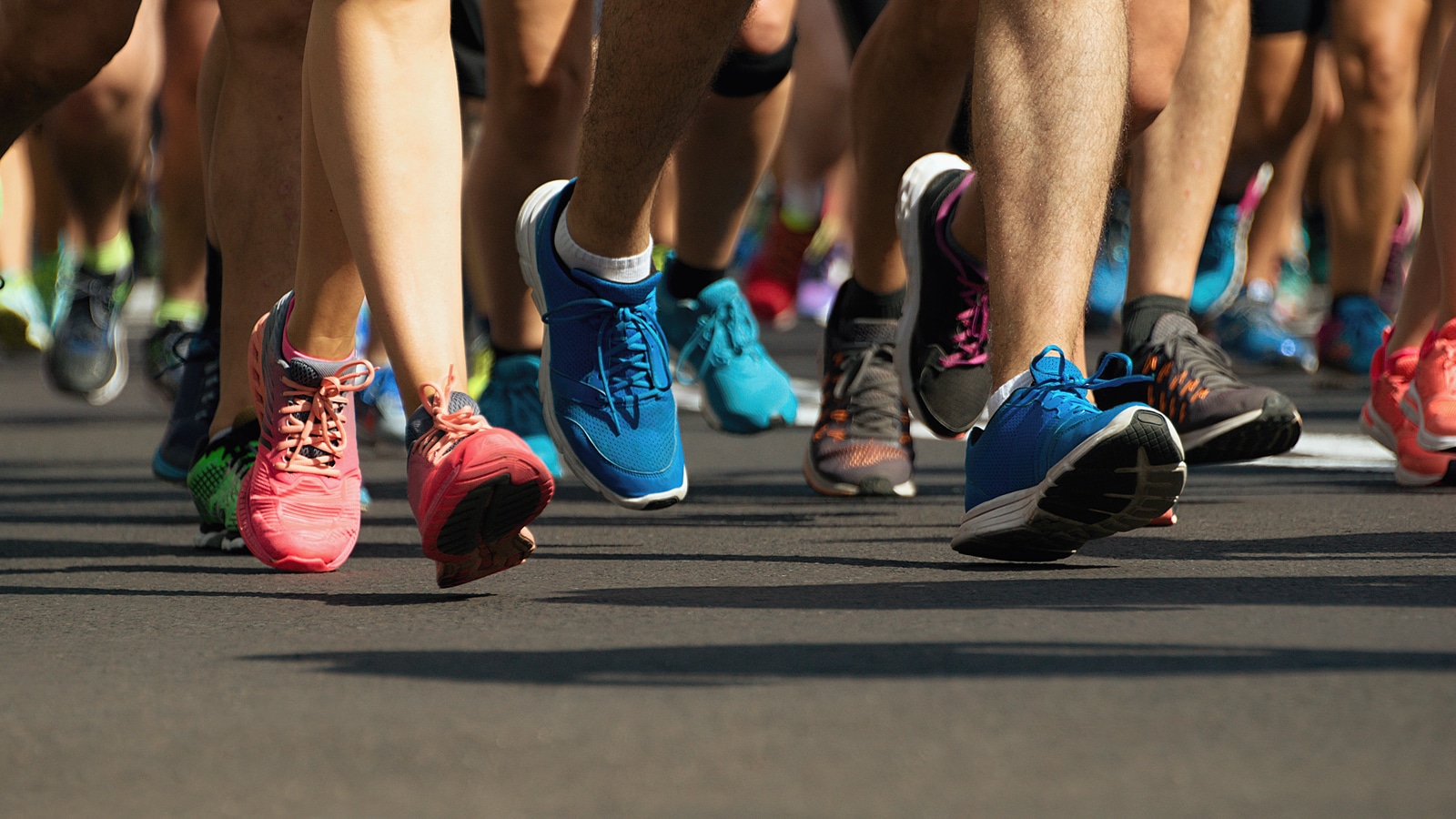Running 2 Miles A Day: Weight Loss, Benefits + Transformation
Running 2 miles a day could be one of the easiest steps you take to make a life-changing transformation. Just two miles. That’s all it takes to access all the health benefits of running from weight loss to better cardiovascular health.
Some people see their 2-mile-a-day habit as a vital part of their morning routine. Others take up running 2 miles a day to get fit or to help them return from injury. You can even use a 2-mile daily run to help improve running speed. Whatever your reason for running two miles every day, expect to see some positive life changes.

Why Run 2 Miles A Day?
You’re investing in your health.
The recommended physical activity level is 75 minutes of physical activity at vigorous intensity and 2 days of strength training activity for adults every week.
Run 2 miles a day, add in some strength training, and you’ll access all the physical and mental health benefits of running from improved heart health and cardiovascular fitness, to reduced high blood pressure and maintaining a healthy weight.
Just from a 2-mile-a-day daily running habit!
It’s not much really. Run two miles in the morning and your fitness routine is done and dusted for the rest of the day.
Slink into work with a little smile of satisfaction and feel those endorphins flow. Running makes you more alert, boosts your mood, and can make you more productive.
For many people, running regularly isn’t about completing marathons or running a fast 10K. It’s about creating a sustainable and enjoyable routine that helps them maintain their health.
And running 2 miles a day is the perfect way to do it!

Running 2 Miles A Day To Lose Weight
Sorry to disappoint you but running isn’t the perfect fix for weight loss. It can certainly help you lose a few pounds: running two miles will burn around 200 calories. But it’s not a miraculous weight loss fix.
The problem is people make some big mistakes when they start running 2 miles a day to lose weight:
Mistake #1 Eating Too Much
Running every day isn’t an excuse to start the see-food-and-eat diet! You know what I mean. You’re so pleased with yourself. You’re running 2 miles a day and feel great.
So you’ll just treat yourself to a piece of rocky road with your morning coffee.
Now running may have an impressive calorie burn compared with other types of exercise, but your average sticky treat will easily wipe out the calories you’ve burnt on your daily run. If you’re running to lose weight, your run isn’t an excuse to pile on the calories.
Mistake #2 Using Sports Drinks And Energy Bars
Pre-workout shots, sipping energy drinks during your run, and fuelling your recovery with post-workout shakes or energy bars. The sports nutrition industry goes into overdrive convincing us we need this stuff to fuel our runs and workouts.
These drinks and energy bars are packed with calories. If you’re just running 2 miles a day you don’t need any of it. Especially if you’re trying to lose weight.
Water is all you need to rehydrate during and after a 2-mile run. Or when it’s hot, watermelon makes a great post-run snack. It’s almost 92% water and a good source of the electrolyte potassium.
If you run fasted in the morning, just refuel with your normal breakfast!

Mistake #3 Failing To Calculate Calorie Needs
When you’re running you need a calorie deficit to lose weight. A calorie deficit is when you expend more calories than you consume. It doesn’t have to be huge but it needs to be consistent.
You can use our daily calories burned calculator to calculate your total daily energy expenditure (TDEE).
This helps you work out how many calories your body needs each day to maintain its current weight – based on your activity level and body size. You can then reduce your calorie intake slightly to create that calorie deficit.
Calculators are only a guide but it can be worth tracking the calories you eat for one or two weeks to see if there is a big mismatch between the calories your body needs and the calories you’re actually consuming.
If there is, try and make some small sustainable changes to your diet to create a calorie deficit. This brings us to the next big mistake:
Mistake #4 Ignoring Nutrition
When you increase your activity level by running 2 miles a day, your body can start telling you it’s hungry. That it needs more fuel.
Sugary snacks and high-fat processed food can start to look very tempting but it’s not what your body needs. That’s the type of food that added those extra inches to your waistline in the first place.
A runner’s body needs good nutrition. Even when you run short distances such as running 2 miles a day.
Start by asking the right questions:
- Am I eating enough lean protein?
- Do I fill up at every mealtime with a big portion of vegetables?
- Do I try and eat the colors of the rainbow – a variety of different colored fruits and vegetables to make sure I’m getting all the nutrients I need?
- How much fiber do I eat every day?
- Am I getting the carbohydrates I need from whole grains, fruit, and root vegetables?
- Am I eating healthy fats or is my diet high in saturated fats and trans fats?
If most of your calorie intake comes from food with little obvious nutritious value, you’ll not only be hungry all the time – your body won’t be getting the fuel it needs to improve as a runner.

How Much Weight Will I Lose If I Start Running 2 Miles A Day?
Your weight loss from running 2 miles a day depends on keeping your calorie intake within your daily energy needs minus the calories burned running 2 miles.
For example, using the daily energy expenditure calculator, a 5′ 7″ woman aged 35 and weighing 160 lb with a sedentary lifestyle, has a daily caloric intake of 1747 kcal/day.
If the same woman takes up running 2 miles a day at a pace of 11 minutes per mile, the running calories burned calculator shows a calorie burn of 251 calories for the 22-minute run.
Based on the theory it takes a 3500 calorie deficit to lose one pound of body fat, a 160 lb person running 2 miles a day will burn 7530 calories a month and lose just over two pounds in body weight.
This assumes their caloric intake remains within their daily requirements of 1747 kcal/day and their running is additional calorie burn.
Of course, everyone’s different, and people with a high BMI will burn more calories, but this is a rough guide of how much weight you can expect to lose when you start a running habit of running 2 miles a day.
Related post: How Much Should I Run To Lose Weight?
How Running 2 Miles A Day Helps With Weight Loss
You can compare the pros and cons of diet vs exercise but to lose weight you really need both.
Eating a balanced diet and cutting calories isn’t enough to hit weight loss goals. Without exercise, there’s a danger of losing lean muscle mass which in turn lowers your metabolism. You become weaker and it’s harder to lose weight.
Losing weight is easier when you exercise. Just 2 miles a day is an achievable distance for most people – you’ll improve your body composition by building stronger leg muscles and in turn increase your calorie burn.
Daily running can also improve your mental health and help with sleep patterns – two additional benefits for weight loss.
How Long Does It Take To Run 2 Miles?
It depends on how fast you run. If you’re a complete beginner it could take 25-30 minutes to run 2 miles especially if you’re taking walking breaks or following the run walk method and alternating running with walking.
But expect your speed to be slower if you’re carrying a lot of excess weight or returning from injury.
When you run regularly, your running times will start to improve rapidly. You’ll be amazed how quickly you can improve in the first few weeks.
When you run regularly, expect to be able to run two miles in 16 to 22 minutes.
How fast you should run and your running speed depends on your fitness level and ability.
If you normally run long distances, cutting back your training mileage to just two miles a day, plus one to two sessions a week of high intensity interval training, can be a good way to improve your running.
The best thing about running two miles a day? It doesn’t take very long. Even people with the busiest schedules can find 30 minutes to run.
Related post: How Long Does It Take To Run A Mile?

Running 2 Miles A Day Transformation
Building a running habit isn’t just about the benefits of aerobic exercise and increasing your physical activity.
Running regularly can have a profound impact on your outlook affecting both your daily life and your mental health.
Here are a few things that can happen:
#1 Running Makes You More Determined
If you can make yourself run every day rain or shine, just think of the other things you can achieve in life!
You will start believing in yourself. You’ll realize you can do anything if you put in the effort.
When setbacks occur, you’ll be able to push through because running has made you a stronger person.
#2 You’re Creating A Healthy Habit
Having one good habit in your life can lead to others. It’s a process called habit stacking where you build one good habit on top of another.
If you’re running in the morning you might start going to bed a little earlier at a regular time. Perhaps you’ll eat a healthy breakfast after going for a run.
These are extra healthy habits that can come from running 2 miles a day.
#3 You’ll Stop Sweating The Small Stuff
Taking time out of the day to exercise is a great mood booster and also helps to put life in perspective.
You’ll quickly realize that most of the petty everyday things that crowd your thoughts just aren’t worth worrying about.
Run, clear your mind, and focus on what really matters in your life.
#4 Running Can Give Your Life Meaning
Am I being serious? It’s a lot to ask of running 2 miles a day!
Well, your two-mile training run may seem insignificant but it’s giving you a reason to get up in the morning and face the day.
Some people will use this habit to set bigger goals – running a marathon or even an ultra race.
Others will see it as a step towards getting in shape and having the confidence to go on a date.
Looks shouldn’t matter and they don’t matter as much as some people think. But if running every day can help you think positively about your body, enough to go out and seek new experiences – that’s giving your life meaning.
#5 Regular Running Improves Your Health
From a runner’s high to a prolonged life, cardio exercise such as running is one of the best ways of improving your health.
Hit your weight loss goals and use running to maintain your weight. You’ll benefit from a long list of health improvements from reducing the health risks of chronic diseases to growing more blood vessels for improved artery health.

How To Start Running 2 Miles A Day
If you’re a complete beginner, use the walk run method where you alternate running with walking. Start with running for 1 min and walking for 2 minutes. Alternate running and walking until you’ve covered 2 miles. You could even follow the walk run method in the Couch to 5K plan.
Gradually increase the length of your running time and reduce your walking time. You may need to take active rest days where you walk 2 miles instead of run. Walking days will give your body a chance to repair and recover.
Your progress will depend on your personal fitness level. Some people will quickly dispense with walking and by the end of the first week be able to run 2 miles consistently.
Others will still be taking walking breaks after 2 or 3 weeks.
It doesn’t matter. All that matters is that you’re making progress and getting fitter.
Be mindful of your body, and if you feel any tight muscles or persistent niggles, take a rest day or walk instead of running.
Related post: How To Start Running When Overweight
Tips To Run 2 Miles A Day
Follow these tips to succeed at your 2 miles a day challenge:
Plan ahead
Add your runs to your daily schedule. If possible run at the same time every day. It helps to develop a habit.
Running shoes
Make sure you have comfortable running shoes with good cushioning and support. Don’t rely on a pair of old trainers you found at the back of the cupboard.
Pick a route
It’s best to know where you’re running before you set off. When you’re running the same distance every day you can still mix things up and improve your running motivation with different routes. Or try running your route in the opposite direction.
Get your kit ready
It’s a big help to lay your kit out the night before if you’re running first thing in the morning.
Try meal planning
If you’re running to lose weight, meal planning can help. It saves time and helps you stick to a healthy diet.
What To Expect Running 2 Miles A Day
Commit to a goal of running 2 miles a day for 4 weeks and this is what you can expect:
Week 1
For the first few days, you’ll be all fired up, and running 2 miles a day will be a breeze. Whenever I’ve used the 2 miles a day program to regain fitness after a layoff, I find I’m bounding out of bed and probably setting off far too fast.
By the end of the week, it’s a different story. Expect to be a bit stiff and sore. Suddenly, even if you’re used to running, two miles can seem a long way!
Not many people lose weight in their first week. The extra running causes small micro tears and inflammation in your muscle fibers. The result is water retention.
You may even gain weight but don’t fret – it’s just water. Everything will correct itself in week 2.
The extra running can make you hungry – try to make nutritious food choices that fill you up without busting your calorie targets.
Week 2
This week can be tough. Fitting in a two-mile run every day is still a long way off from becoming a regular habit.
Your entire body can feel worked and you may struggle to see the benefits.
Hang in there. It gets easier in week 3.
Week 3
I like to think of this as breakthrough week. The aches and pains subside and you start to see why you’re putting yourself through this challenge.
Running becomes easier, you’ll feel fitter and notice some changes in your body. Better muscle definition and, if you’ve been watching what you eat, expect to see the weight go down on the scales.
Week 4
Congratulations – you’re nailing it! Running 2 miles a day should now feel natural. Something your body expects. Something you miss if you skip a day.
Expect to feel stronger, lighter, more alive, and just a little smug!

What Happened When I Ran 2 Miles A Day For A Month
Running 2 miles a day is a great way of increasing your physical activity and can make a huge difference to how you feel about your body. But everyone will have a different experience. It all depends on your current fitness.
I’ve been running most of my life. So when I ran 2 miles a day for a month it wasn’t ground-breaking but it did improve my running consistency. I combined running 2 miles a day with some speed sessions and I loved the results. I got a PR for a 5K, felt stronger as a runner, and reduced my body fat percentage.
Your experience could be completely different if you’re a beginner runner and you don’t normally exercise. 2 miles a day may not sound much but it will be a big challenge to your body. Expect great things. It’s going to feel tough at times but it’s worth it.
Some people will see 2 miles as an achievable distance they will continue to run as a long-term habit and for others it will be a stepping stone to running further – running 3 miles a day, running 5 miles a day, training for a half marathon, or a longer race.
Be aware of the diminishing returns of any new activity. As your body adapts to running two miles a day, you may need to adjust your training to get the same results. Maybe run faster or find a more challenging running route. Find out more about how to run every day and the benefits of everyday running.
But the key here is to enjoy your running. You’ve conquered a huge challenge and should be proud of yourself.







